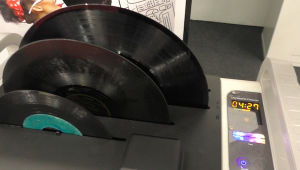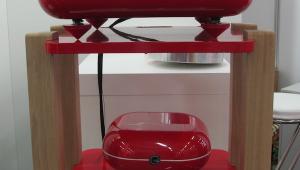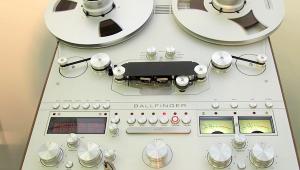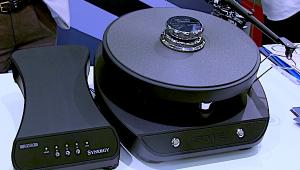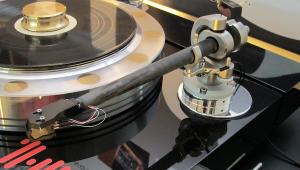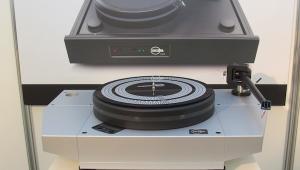looks like it was intentionally done to me.
Have You Seen Much of This On Your New Records?
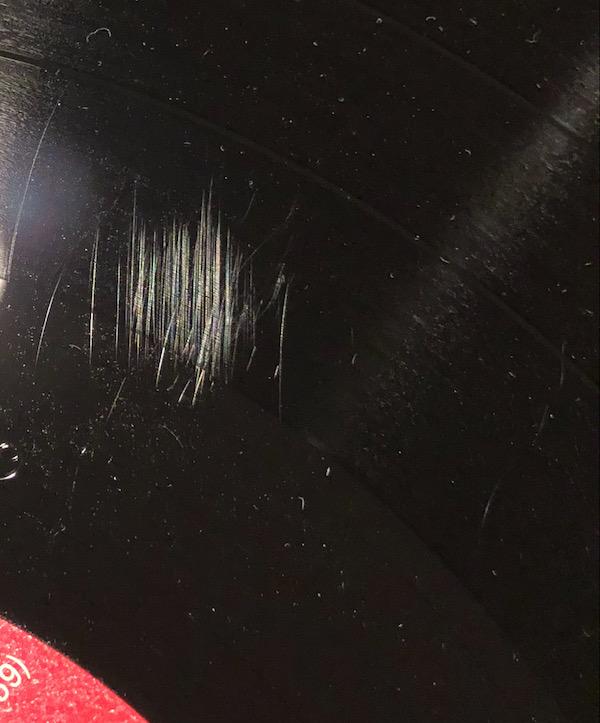
The good part is that despite the grizzly visuals, it was inaudible and only noticed while flipping over the record in an unflattering light. The record was brand new and sealed, and there's no way it could have been a returned record re-shrink-wrapped so it left the plant like this. Your recent experiences?
- Log in or register to post comments


I have seen this at least a dozen times. First couple of times I was worried. I cleaned the records and the marks were still there. The sound was not effected on any of the records. So I stopped worrying about it but it is weird.

Unfortunately I have seen this more times than I’d like. It’s never been a problem exchanging them, but it’s disconcerting nonetheless.

The fact that it seems as if flowing center out makes me think there is something on the pressing surface of the virgin vinyl...contaminates in the air, dust of some kind before the press closes. Surprising as you would sure think you could hear it.

I used to see scuffs on UK white label promos in the 1990s. If I happened to pick up an actual release months later, the scuff would always be absent. I always figured it originated in the playing stage but have never known for sure ¯\_(ツ)_/¯

Chad & Co. at QRP. I'd bet that they would have an idea as to the cause of the blemish.

The inner sleeve on 'Soul Journey' is a printed card type ... at least on the two copies I have seen? QRP should have used its own anti static inner sleeve ideally but we don't know the 'politics' that are involved. Many artists prefer a printed card inner sleeve with lyrics and somehow are blissfully unaware of the damage that card sleeves can inflict on delicate vinyl surfaces. As I say (a lot these days) .. 'It would never happen in Japan'.
Presumably, the damage shown on the photograph is actual physical damage as opposed to a 'horns' issue? I see marks like this once in a while but they usually arise because the metal parts have not been de-horned, if that makes sense? Damage such as that shown can also arise from stray 'shards' of vinyl that somehow get into the inner sleeve and wreak damage with movement during transportation etc. That has certainly happened to me. If I recall correctly, I did notice a few stray pieces of vinyl with my first copy of 'Soul Journey'.
Off point Michael, have you any plans to review some the vinyl reissue releases that SONY has released on the Japanese domestic market? CD Japan has some featured on its website including a reissue of Bob Dylan's 'Blonde On Blonde' (2LP), now unavailable/sold out apparently? http://www.cdjapan.co.jp/product/SIJP-1004?s_ssid=e42a215b97f0e5595e

Certain papers have very stiff fibers and certain coatings that cut the vinyl. Worse is whan that type of sleeve "grabs" the vinyl so even removing it the first time does some serious visible damage. In some cases I've had to carefully cut open such sleeves to get the vinyl out safely. Sometimes these scratches are audible, sometimes not. The is a preventable problem... returning such products is the only way they'll learn and hopefully improve things in this area.

Looked bad but barely audible.

Just happened to me this moment. Cracked open a Brand new pressing of Lou Reed's Rock n Roll Animal and visible and unfortunately able to hear scratches middle of Side 1. Of course a quiet spot that covers nearly 2 minutes. Shame since nice sounding remaster otherwise

I got a new record with similar damage and sent it back, the replacement had the exact same marks on the same cut. I figured it was a pressing flaw. It was a Bluenote record. I had another Bluenote from a different artist that was unplayable as well. Not sure what plant they use.

Only tangentially related to this... In the late 70s, every classical record I bought from the Deutsche Grammaphon and Philips marques were essentially perfect. The record was always a shimmering black, the in and out groove areas looked polished and the edge was a very crisp square, without that annoying bead or the spur most records had near the edge back then. Why can all records not be made like that? Whatever DG or Philips was doing still has no equal — the vinyl, the sleeve and the jacket.
Sadly, from an audiophile perspective, both marques left a lot to be desired. Very obvious close miking for clarity did away with any sense of ambiance. All these records were also easy to track maybe because crescendoes were all compressed or filtered of transients.
Still, they looked and felt amazing — a sight to behold before playing.

If you truly think so, you should be able to replicate the scratches yourself using a paper sleeve. Surely you have at least one disposable LP to use (but as you said the scratches are inaudible, you shouldn't hesitate to use a most-prized LP).

When purchasing older Columbia LPs, they often come in a U-shaped sleeve made of something the thickness of Saran Wrap.
Do you know what the era was record companies used this?

Yes, unfortunately my copy of Swing Out Sister 'Almost Persuaded' has similar markings on both sides, not as severe looking but certainly audible.

This looks way beyond what paper can do. I've bought hundreds, or thousands, of LPs in paper sleeves. Never seen a concentrated area of scratches anything close to that.
Again, looks like it was done intentionally.

a very long time (much of what I listen to has not been re-issued for one thing), but I do recall past purchases back in the day. Records always in paper sleeves new back then except for classical, which was always in lined sleeves or otherwise (I wonder why that was?), I digress.
Anyway, the new records always looked all pure and iridescent in certain angles, but under certain lighting I could see hairline scratches all over the record, not really concentrated in one spot. This is especially indicative of paper sleeves. I t also what we lived with as it did not effect sound 99% of the time. (Later we learn about diskkeeper sleeves and the like).
Judging by the picture though, that to me doesn't look like a paper sleeve issue in this case. It does look intentional or some accident during pressing.
Why they still use paper inner sleeves and don't use lined inner sleeves or what have you today is beyond me. I understand paper sleeves are cheap, but with new record prices starting at $30 and up, even counting the expense of manufacturing there is still enough embedded in the price to afford to use better inner sleeves.I'm somewhat surprised this is not a standard at this point, just out of respect for the vinyl if nothing else.

Wonder if that's caused by handling while in the paper sleeve ?
I got a surprise when I opened my new copy of Mark Knopfler's "Privateering" a few years back. They didn't use paper or poly sleeves. It was cardboard ! The outside of the sleeve had illustration, the inside was untreated. Yikes. Mofi sleeve to the rescue.

I'll never forget opening The MJQ at Carnegie Hall on MOFI for the first time and hearing a disconcerting "ZIP" as I slipped the LP out of the sleeve.
The rice paper sleeve had been pressed through the spindle hole creating a point that scratched every groove audibly!
It was an easy replacement (Thanks, Needle Doctor!) but the replacement also had the rice paper pressed through the spindle hole. At least I was smart enough to look for it the second time - and every time since...

Have seen lots of that I think it's definitely plain paper sleeves or plain cardboard sleeves! It often appears together with cut sleeves on both sides. I personally think that a lot of surface noise comes from shipping in inappropriate sleeves. Maybe a downside of online shopping it raises the risk of damaging records by shipping. I can not believe that investing in poly sleeves would exceeds costs for callbacks from customers!

I recently bought a copy of the new Polydor pressing of The Moody Blues - On The Threshold Of A Dream. This 1969 LP is a classic and we could use some good clean reissues but there were problems with this LP.
First of all many people will complain that these pressings are dull and lifeless. They aren't. They are cut a bit differently and you need to play it as you would a 200+ gram pressing.
Once that is adapted to, the missing treble will be revealed. Its not a case of using the VTA to add treble it is really cut that way and if you make the change that I recommend you will find that the LP has good balanced sound quality and is not dull and lifeless.
The sound quality is very good for this pressing (as well as the other Polydor Moody Blues pressings). These are all mastered by Abbey Road and the quality of the mastering, the cover and its inserts are all very good. It just sounds dull until you make the aforementioned change.
The other problem that I had with this particular pressing is on the last 30 seconds of side B. The LP played quietly and without any faults until I got to that last 30 seconds where it stops and stuck, skipping in place.
The pressing did not have fill at those last grooves and there were no grooves for my stylus to follow after that point. I called the dealer (Acoustic Sounds) and got another copy. The second looked like it may have the same problem but I tried to play it back.
The second copy played fine until I reached the last 5 seconds of the last track on side B. The last track was fading out and it again stuck and skipped in place.
Be aware of this pressing. I have had two of them with the same problem. Once again it is the Polydor Moody Blues - On The Threshold of a Dream.
Ed

The "skipping" of the last track (Have You Heard, Part 2) is probably deliberate for the LP version of this album. The track plays during the run-out spiral and continues endlessly in the concentric groove (if your turntable does not have auto arm return). It's similar to the side 2 ending of the Beatles' "SPLHCB" (except the original North American Capitol pressings).

We all know Mr. Fremer's love for records. These scratches are obviously from Michael's 5 O'clock shadow abrasing the vinyl while he cuddles with it during a nap.

YES! I get this all the time, and other blemishes. I've always just assumed it happens from shifting around inside a paper sleeve during shipping. Sometimes audible, other times not audible. I've also had loose pieces of vinyl break off and gouge out scratches that are very audible. However, these issues usually are with the newer music i purchase that are pressed at shitty plants. I've not yet had issues from RTI, QRP or Pallas. (knock on wood)

Thank God! But the amount of dirt an dust I've been getting on expensive audiophile LP's has led me wonder just what'd going on at some of the pressing plants.

Watch any "how a record is made" video and you'll see it's a very industrial process.
I wouldn't be surprised if more than one pressing house just leaves the doors open in the summer rather than pay to air condition the facility.

I've been buying LP's continually since the mid 1970's except for a few years in the early '90's when I switched to CD and I think I con honestly say that I've never seen so many LP's come out of their bags in such condition. My guess is that the pressing plants have become so overloaded that to save time they've stopped giving LP's the final rinse and polish. But at the end of the day it's nothing that a quick run through the cleaner doesn't fix so for me it's no more than an minor gripe.

Back in the early 80s, Stereo Review published a good article cataloging/explaining many vinyl manufacturing defects. It's time to republish/update it, no?

If it is indeed the paper sleeves causing the surface abrasions this is about and not additional factory factors, there is at least one thing that can be done to minimize this. Since we can't do anything about how it was inserted into the paper sleeve originally, at least we can avoid adding our own scuffs to this. Blow into the sleeve to separate the paper from the record and carefully take it out the first time. Don't just slide it out, anxiously awaiting the play from the new acquisition. [Clean it! Not the rumored "mold release" problem - the vinyl itself exudes plasticizer oils while new.] Then replace the sleeve with a good one if you don't do this as a matter of course anyway like I do.
Always did expect some scuffing from paper, obviously more abrasive than poly or rice. This has been my way, since the late 60's, anyway, which feels like forever by now.

This little article takes me straight back to my youth. It really does.
Buying records. Getting home, and slitting open the shrink wrap. Pulling the thing out to find ----- ya never knew what was going to emerge ----- any one or more of several dozen pressing defects.
Anything from a scratch that would cause a tone arm to skip or stick, to Himalaya-like warps that would cause a tone arm to fall with a deep, once-a-revolution THUMP.
And, so many, many, many more wonders. Such as this one, posted right here in this thread by EdAInWestOC:
"The LP played quietly and without any faults until I got to that last 30 seconds where it stops and stuck, skipping in place."
Ahhh, glorious, glorious vinyl.
Vinyl and outdoor outhouses forever.

If you've seen the original "Bedazzled," you'll know exactly the demonic forces at work here!

It is possible that the scratches are due to paper sleeves or contamination (such as a spec of almost anything that is harder than vinyl) that is on the record or the inside of he sleeve. The records get packed together tightly in a box for shipping and the box is put on a truck. During the truck ride the box is slightly shaken (usually up and down) and that is what actually causes the scratch by rubbing the spec or paper flaw up and down on the vinyl.

I have experienced a number of issues lately that have gotten to point where I finally wrote the manufacturer to complain. The normal routine is I return to my dealer and frankly, I feel the return rate is now anecdoting my local relationship. I outlined my history of buying new and used since the 70's, own dozens of their premium LP product and how I loved the mastering and quality of the product but cited 3 recent instances where I have been disappointed by perceived damaged goods. The last straw was a 2 LP set that had a line/mark running from the spindle hole to the outer edge on side 3. The record sleeve and jacket showed no sign of damage and side 3 was placed facing the interior of the gatefold. To their credit, they assured me I would encounter no trouble returning to my dealer and even offered to take it back until they discovered I'm in Canada. They even followed up and asked me for pictures, which I sent and which they said they would discuss with the plant. @ Michael Fremer: I don't see how I can attach the photos but I am happy to send them as I feel we might all benefit from this. My take on this issue is it appeared the vinyl encountered some mechanical interference being moved from the press to the sleeve. The story has a happy ending: I just opened the New Procol Harum A Salty Dog remaster and it is superb in all respects.

I always thought this might be from when the LP comes out of the press and slides onto the spindle, as it looks a lot like the concentric surface marks LPs used to get when used on record changers as a record would drop down onto the already spinning record on the turntable.

on my Kinks mono box set unfortunately. Luckily...not as bad as the pictured example. But there has to be more to it than simply paper sleeves IMO. Yes, The Kinks set did come with the cheapo variety. But, I’ve been buying records with paper sleeves for almost 50 years, and I don’t recall seeing it until recently. Now...dirty records in dirty paper sleeves....I’d buy that.

many times, just not to that extent. I find it hard to believe a vinyl shard would inflict THAT much damage in transit. But anything is possible. I wanted to thank MF for finally using his influence in this much needed area.

Yesterday I seen the same on a 1986 Qualiton record I bought on a garage sale. I didn’t even noticed it in the beginning.
It is when the record was trough when I wanted to put it off that I noticed that. It surprised me because the record played well without any surface noise.
All my records are ultra sonic cleaned with Klaudio and Keith Monks before playing for the first time.

Scorpio Records in the Trenton NJ area had better quality on their counterfeits some 10-15 years ago than today's record plants. WTF?
Crazy thing, the few counterfeits I ended up purchasing that were manufactured and distributed by them had perfect LP covers and identical copies of the original labels on the LP's. The Source, Probably CD's? LP's were $5-$12 a pop. Just crazy that they got away with it for so long.

I just received five test pressings of my band's latest project. A similar (but smaller) scuff was present, but inaudible. It was identical on all five records. That could only mean that the blemish was present on the metal stamper.


